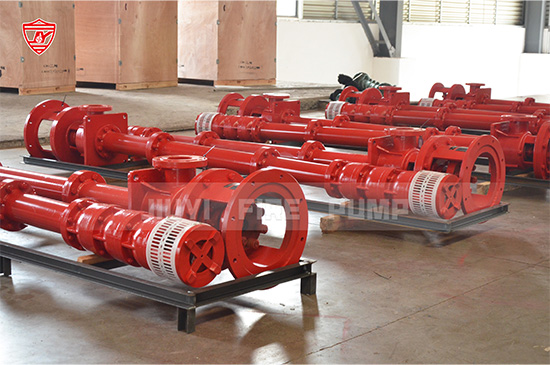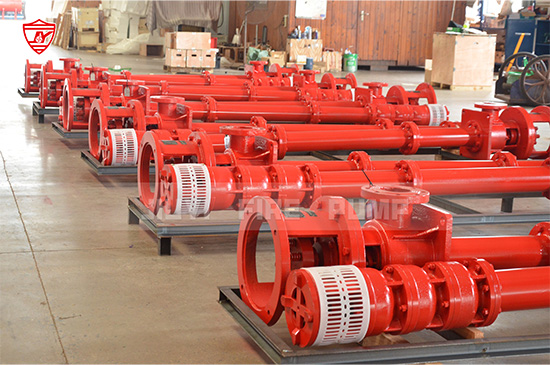Vertical turbine pumps (VTPs) are widely used in fire protection systems, municipal water supply, industrial facilities, and agricultural applications due to their high efficiency, reliability, and ability to handle large water volumes. For fire safety systems in particular, vertical turbine fire pumps are critical because they provide a steady and dependable water supply during emergencies.
One of the most common questions we hear from customers is: “How long do vertical turbine pumps last?”
The answer depends on several factors, including the pump’s design, installation quality, operating conditions, maintenance practices, and manufacturer quality standards. In this article, we’ll explore the average lifespan of vertical turbine pumps, what affects their longevity, and practical steps to extend their service life.

Generally, a high-quality vertical turbine pump can last 20 to 30 years or even longer when properly maintained. For fire protection systems, where pumps often remain idle and are activated only during emergencies or routine tests, their mechanical wear is lower compared to pumps used in continuous-duty operations.
Typical lifespan range based on application:
Fire protection vertical turbine pumps: 25 – 30 years
Industrial water supply pumps: 15 – 25 years
Agricultural irrigation pumps: 10 – 20 years
Municipal water systems: 20 – 30 years
However, these figures assume the pump is installed correctly, maintained regularly, and operated within the manufacturer’s specifications. Poor maintenance or improper installation can drastically reduce service life.
The quality of the pump’s materials, engineering, and manufacturing process significantly impacts its durability. For example:
High-grade stainless steel bowls and shafts resist corrosion better than cast iron.
Precision-engineered impellers reduce vibration and wear.
UL/FM-certified vertical turbine fire pumps are designed to meet stricter reliability standards, ensuring a longer operational life.
Even the best pump won’t last if installed incorrectly. Misalignment, poor foundation support, or improper suction and discharge piping can cause:
Excessive vibration
Bearing wear
Shaft misalignment
Reduced efficiency
Engaging certified professionals for installation and ensuring compliance with NFPA 20 or local fire safety codes is essential.
Vertical turbine pumps are often used in environments where water quality varies greatly. Water containing sand, silt, or other abrasives can cause impeller and bearing wear. To prolong pump life:
Use strainers or suction screens to prevent debris intake.
Consider hard-coated or hardened material impellers for abrasive environments.
Fire pumps are typically standby systems, meaning they only operate during emergencies or periodic testing. This naturally extends their lifespan compared to pumps used in continuous operation for municipal or industrial purposes. However, standby systems can still deteriorate if not tested regularly.
Routine inspection and maintenance are the most important factors affecting a pump’s longevity. Neglecting lubrication, bearing checks, alignment, or motor performance testing can lead to premature failure.
Humidity, extreme temperatures, and exposure to corrosive atmospheres can reduce component lifespan. Protective coatings and weatherproof enclosures help safeguard pumps operating in harsh conditions.
To maximize the lifespan of your vertical turbine pump, we recommend the following maintenance practices:
For fire pumps, NFPA 25 recommends:
Weekly churn tests (running the pump without water flow)
Annual flow tests to verify performance
Bearings and column shaft bearings should be lubricated according to manufacturer guidelines. Both oil-lubricated and water-lubricated column bearings require regular inspection to ensure smooth operation.
Excessive vibration often indicates misalignment, unbalanced impellers, or bearing wear. Install vibration sensors or perform periodic vibration analysis to detect issues early.
Misalignment between the pump and driver (motor or diesel engine) can lead to mechanical stress. Always recheck alignment after major maintenance or motor replacement.
Inspect impellers and bowls periodically for corrosion, pitting, or cracks. Replacing or rebalancing worn impellers improves efficiency and extends pump life.
Shaft sleeves protect the shaft from wear in critical areas. Replacing them before severe wear develops can prevent costly repairs.
For vertical turbine fire pumps powered by electric motors or diesel engines, maintaining the driver is just as important as maintaining the pump itself.
Even with excellent maintenance, every pump eventually reaches the end of its useful life. Watch for these warning signs:
Frequent bearing failures or seal leaks
Noticeable drop in pump efficiency
Excessive vibration and noise despite balancing efforts
Persistent overheating
Difficulty meeting required flow or pressure during testing
If several of these issues occur simultaneously, replacing the pump may be more cost-effective than repeated repairs.
When investing in a vertical turbine pump, especially for fire protection systems, choosing a reliable manufacturer can make a significant difference in long-term performance. Look for:
UL Listed / FM Approved certification
Compliance with NFPA 20
High-quality materials suitable for your water conditions
A strong after-sales service and technical support team
At Better Technology Group, we design and manufacture vertical turbine fire pumps built for durability, efficiency, and reliability. Our pumps undergo rigorous testing to ensure optimal performance under demanding fire safety conditions.
Select the right pump size: Oversized or undersized pumps experience premature wear.
Invest in quality bearings and shaft materials: High-grade alloys extend component life.
Use protective coatings: Epoxy or ceramic coatings reduce corrosion in aggressive water conditions.
Automate monitoring: Integrate SCADA systems to track pump performance and detect early anomalies.
Schedule professional inspections: Certified technicians can identify potential issues before they escalate.

Vertical turbine pumps are built to last, especially when designed, installed, and maintained correctly. With proper care, a high-quality vertical turbine fire pump can reliably serve your fire protection system for 25 years or more.
If you’re considering upgrading or installing a new vertical turbine pump, always focus on quality manufacturing, proper installation, and regular maintenance. By doing so, you’ll ensure your pump operates efficiently, meets fire safety regulations, and provides maximum protection when you need it most.